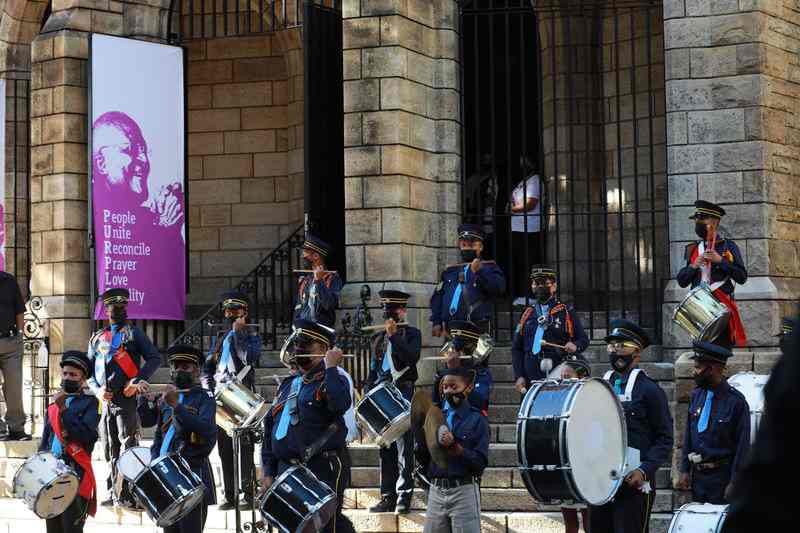
The coffin carrying the body of Anglican Archbishop Emeritus Desmond Tutu arrives at the St. George’s Cathedral on Friday where he will lie in state for a second day in Cape Town, South Africa.
7:35 JST, January 1, 2022
CAPE TOWN, South Africa (AP) — South Africans from all corners of retired Archbishop Desmond Tutu’s “rainbow nation” filed past his plain pine casket by the hundreds on Friday to pay their respects to his life of activism for equality for all races, creeds and sexual orientations.
“He was a moral giant. He was a moral and spiritual giant loved and revered for fighting for equality for all people,” said the Rev. Michael Lapsley, on the steps of the historic St. George’s Cathedral after Tutu’s coffin was carried in amid music, incense and prayers.
Anglican clergy — women and men, Black and white, young and old — lined the street to honor the cortege carrying Tutu’s body to the church. Members of the Tutu family accompanied the casket into the cathedral.

A band plays music as they await the arrival of the coffin carrying the body of Anglican Archbishop Emeritus Desmond Tutu where will lie in state for a second day at the St. George’s Cathedral on Friday.
People began filing through the lofty cathedral to light candles and view the small, simple coffin with rope handles which Tutu had said he wanted to avoid any ostentation or lavish expenditures. Many sat in the pews to pray and reflect on Tutu’s life.
More than 2,000 people visited the cathedral on the first day of viewing on Thursday and on Friday the line stretched for more than a kilometer (nearly a mile). A requiem mass for Tutu will be held on New Year’s Day before he is cremated and his remains placed in a columbarium in the cathedral.
“His work did not stop with the end of apartheid,” Lapsley said, in reference to South Africa’s regime of racial oppression which Tutu prominently opposed and which ended in 1994 when South Africa held a democratic election.
“Archbishop Tutu bravely championed the equality of all people. He transformed the church by bringing women into the clergy. He championed the LGBTQ community, for whom he is a hero all over the world,” said Lapsley, Canon of Healing at the cathedral.
An anti-apartheid activist priest whose hands and one eye were blown off by a letter bomb sent by South African agents in 1994, Lapsley said Tutu helped him find reconciliation and a new role in the church.
One of the first women priests ordained by Tutu, the Rev. Wilma Jakobsen, said Tutu radically changed South Africa’s Anglican church.
“The face of the church has changed. It has women priests and women in positions of leadership. It has people of all colors. Our church welcomes LGBTQ people. That’s all thanks to the leadership of Archbishop Tutu,” said Jakobsen, who served as Tutu’s personal chaplain when he was archbishop.
At the height of apartheid, Tutu mixed all races in the church, said Jakobsen.
“I was intentionally placed in Mitchells Plain and other white priests were intentionally put in Black communities. And Black priests were intentionally placed in white communities,” said Jakobsen. “Archbishop Tutu did not wait for approval to do that, he just did it. It was a direct challenge to the apartheid regime.”
Among those viewing Tutu’s casket Friday was Mohamed De Bruyn.
“It was very emotional for me,” said De Bruyn. “I could feel his great soul in that little wooden box … He was like Moses. He led our nation from all that sadness and grief.”
Vuyo Wara said Tutu “was a great leader. He fought corruption. I just hope that our current leaders will take his baton and follow his principles going forward.”
After the viewing Friday, Tutu’s body will remain alone overnight in the cathedral, “a place that he loved,” according to a statement from Archbishop of Cape Town Thabo Makgoba.
The cathedral, the Anglican church’s oldest in southern Africa, dating back to 1847, shows the changes encouraged by Tutu. The Crypt Memory and Witness Center has public education programs to encourage healing and social justice.
The graceful stone structure built by British colonialists beneath Cape Town’s soaring Table Mountain was converted by Tutu into a center of anti-apartheid activity. When the apartheid regime banned political gatherings, Tutu held meetings in the cathedral where participants bowed their heads ostensibly in prayer and heard political speeches. Nelson Mandela called it the “People’s Cathedral.”
With her gray hair pulled back in a ponytail tinged with purple, and wearing a brightly colored rainbow mask, the Rev. Maria Claassen said she was paying homage to Tutu.
“He was a very humble man but to sit in the same room with him, you could feel the strength of his presence, of his convictions,” said Claassen, an Anglican priest in Cape Town’s Durbanville area. “He inspired us and now we celebrate his life.”
"News Services" POPULAR ARTICLE
-

American Playwright Jeremy O. Harris Arrested in Japan on Alleged Drug Smuggling
-

Japan’s Nikkei Stock Average as JGB Yields, Yen Rise on Rate-Hike Bets
-

Japan’s Nikkei Stock Average Licks Wounds after Selloff Sparked by BOJ Hike Bets (UPDATE 1)
-

Japan’s Nikkei Stock Average Buoyed by Stable Yen; SoftBank’s Slide Caps Gains (UPDATE 1)
-

Japanese Bond Yields Zoom, Stocks Slide as Rate Hike Looms
JN ACCESS RANKING
-

Keidanren Chairman Yoshinobu Tsutsui Visits Kashiwazaki-Kariwa Nuclear Power Plant; Inspects New Emergency Safety System
-

Tokyo Economic Security Forum to Hold Inaugural Meeting Amid Tense Global Environment
-

Imports of Rare Earths from China Facing Delays, May Be Caused by Deterioration of Japan-China Relations
-

University of Tokyo Professor Discusses Japanese Economic Security in Interview Ahead of Forum
-

Japan Pulls out of Vietnam Nuclear Project, Complicating Hanoi’s Power Plans
























